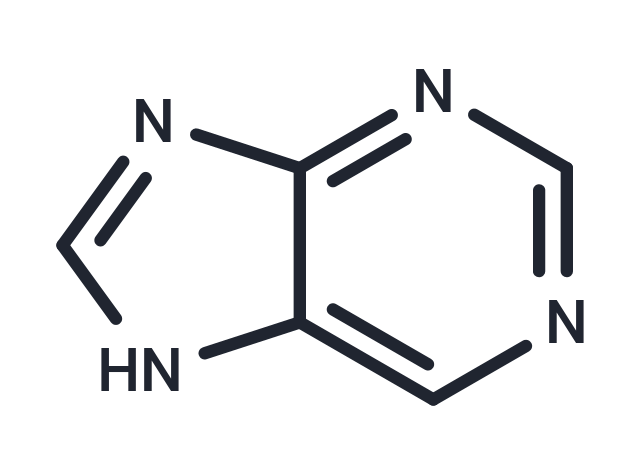 Your shopping cart is currently empty
Your shopping cart is currently empty

Purine (7H-Imidazo(4,5-d)pyrimidine) is a heterocyclic aromatic organic compound, consisting of a pyrimidine ring fused to an imidazole ring. Two of the bases in nucleic acids, adenine and guanine, are purines. Purines from food (or from tissue turnover) are metabolised by several enzymes, including xanthine oxidase, into uric acid. High levels of uric acid can predispose to gout when the acid crystalises in joints; this phenomenon only happens in humans and some animal species (e.g. dogs) that lack an intrinsic uricase enzyme that can further degrade uric acid.

| Pack Size | Price | USA Warehouse | Global Warehouse | Quantity |
|---|---|---|---|---|
| 100 mg | $29 | In Stock | - | |
| 200 mg | $39 | Inquiry | Inquiry | |
| 1 mL x 10 mM (in DMSO) | $30 | In Stock | In Stock |
| Description | Purine (7H-Imidazo(4,5-d)pyrimidine) is a heterocyclic aromatic organic compound, consisting of a pyrimidine ring fused to an imidazole ring. Two of the bases in nucleic acids, adenine and guanine, are purines. Purines from food (or from tissue turnover) are metabolised by several enzymes, including xanthine oxidase, into uric acid. High levels of uric acid can predispose to gout when the acid crystalises in joints; this phenomenon only happens in humans and some animal species (e.g. dogs) that lack an intrinsic uricase enzyme that can further degrade uric acid. |
| Synonyms | 7H-Imidazo(4,5-d)pyrimidine |
| Molecular Weight | 120.11 |
| Formula | C5H4N4 |
| Cas No. | 120-73-0 |
| Smiles | c1nc2ncncc2[nH]1 |
| Relative Density. | 1.472g/cm3 |
| Storage | Powder: -20°C for 3 years | In solvent: -80°C for 1 year | Shipping with blue ice/Shipping at ambient temperature. | |||||||||||||||||||||||||||||||||||
| Solubility Information | DMSO: 22.5 mg/mL (187.33 mM), Sonication is recommended. | |||||||||||||||||||||||||||||||||||
| In Vivo Formulation | 10% DMSO+40% PEG300+5% Tween 80+45% Saline: 2 mg/mL (16.65 mM), Sonication is recommended. Please add the solvents sequentially, clarifying the solution as much as possible before adding the next one. Dissolve by heating and/or sonication if necessary. Working solution is recommended to be prepared and used immediately. The formulation provided above is for reference purposes only. In vivo formulations may vary and should be modified based on specific experimental conditions. | |||||||||||||||||||||||||||||||||||
Solution Preparation Table | ||||||||||||||||||||||||||||||||||||
DMSO
| ||||||||||||||||||||||||||||||||||||
| Size | Quantity | Unit Price | Amount | Operation |
|---|

Copyright © 2015-2025 TargetMol Chemicals Inc. All Rights Reserved.